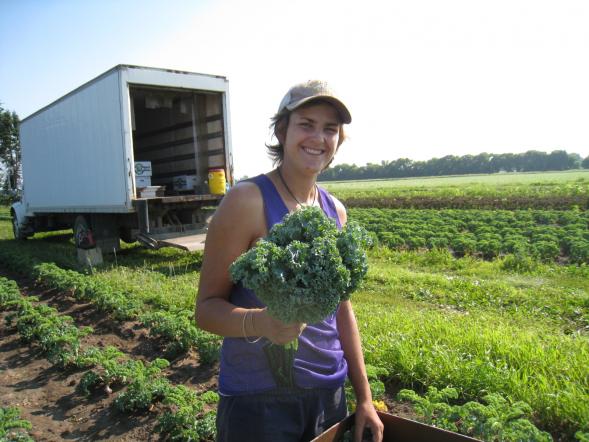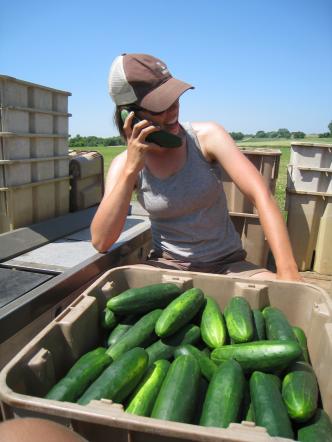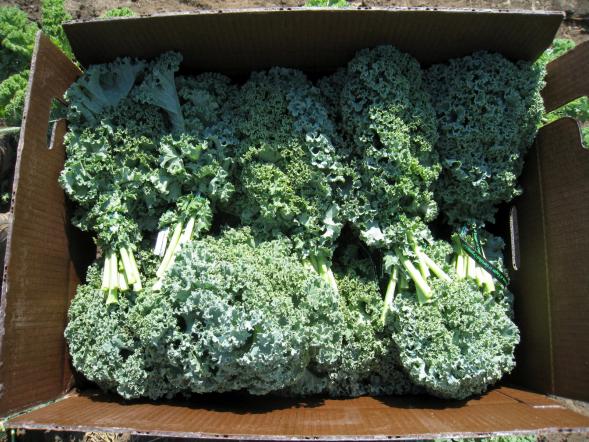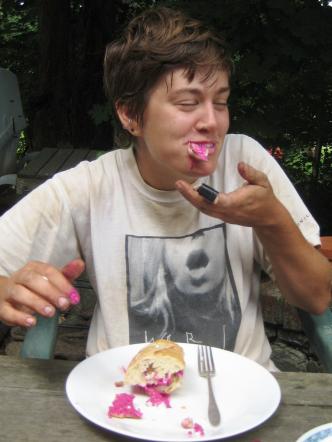This is the fourth post in a summer-long series from a young farmer working as a harvest crew leader at Gardens of Eagan. Check out previous posts, Laying New Roots, When Farmers Stay Dry, and Building Farm Community.
I think I left my back muscles somewhere in the kale field, lost in a sea of lacinato and green curly. Wandering back to my car after work on Fridays, I barely remember how to stand up straight, how to walk without leaning face-down, eyes swimming from one kale plant to the next. My hands fall by my sides, fingers swollen and curled, ready to rotate the perfect bunch of bountiful brassicas. Green and black Gardens of Eagan kale twist-ties show up shredded in my washing machine, lie hidden underneath my car seats, fall out of my hair at night as I toss and turn, dreaming of kale bunches, of red, green, and lacinato.
We grow and bunch and eat kale at Gardens of Eagan like Lil Wayne spits rhymes: all the time. One of only three crops grown on our certified land (our new land is in transition this season), organic kale literally brings home the bacon. The other produce, grown on transitional land, is technically “organic,” but receives “conventional” stickers in grocery stores and, unfortunately, a lower price. So, in comparison, our certified organic kale is a cash crop because it can be planted as early as April, depending, of course on the weather, and its harvests continue until late October; plus, it requires little maintenance – eventually, even the weeding becomes unnecessary.
 Holly with her perfect bunch of kale
Holly with her perfect bunch of kale
Our harvests begin at 7:30 in the morning, before the cool breezes slip away with rising sun, before our shirts hang heavy with sweat, before the tender kale goes limp in our swift bunching hands. Sleep-eyed, Molly, Michael, Holly, and I pick our first cases, each box holding twenty-four bunches, in silence. As our paces pick up and the truck begins to fill, we crank some tunes on the radio, listen to longed-for podcasts of “This American Life,” “Radio Lab,” and “Wait Wait Don’t Tell Me,” and play rhyming word games.
Kale bunches from Gardens of Eagan are always uniform, consistent, beautiful bouquets. As I first watched harvest manager Mike assemble a bunch, feeling with his left hand for the place of each leaf, while his right reached down for another, I stood in awe of his speed and the beauty of his bunch. I’ve come to understand the kale bunch as art, as feeling, as intuition. And we carry this art carefully under our arms as we shuffle and scurry our hunched bodies up and down each row.
---
 Molly talking on her cucumber "phone"By
the time we arrive in the cucumbers, my body crumples over the wild vines. Lost
and camouflaged amongst the leaves, cucumbers sleep silently on
weed-suppressing silver plastic. The first time I picked cucumbers, my knees
wandered away from me; I think I sent them in on the vegetable conveyor belt we
use when harvesting big fields. First squatting and crawling under the “veg
veyor,” I had not yet learned that bending from the waist could be more
efficient, nor was I prepared to find my missing back muscles or wear out my
hamstrings.
Molly talking on her cucumber "phone"By
the time we arrive in the cucumbers, my body crumples over the wild vines. Lost
and camouflaged amongst the leaves, cucumbers sleep silently on
weed-suppressing silver plastic. The first time I picked cucumbers, my knees
wandered away from me; I think I sent them in on the vegetable conveyor belt we
use when harvesting big fields. First squatting and crawling under the “veg
veyor,” I had not yet learned that bending from the waist could be more
efficient, nor was I prepared to find my missing back muscles or wear out my
hamstrings.
Picking cucumbers may be the hardest harvest of the season. Though I’ve grown and eaten cucumbers for a number of years now, harvesting the thin-skinned cucurbit often proves difficult for me. Ripe cucumbers exhibit several signs of readiness: filled-out ridges, full, round ends, and smooth, spineless bumps. Just on the cusp of this classification, many near perfect cucumbers roll in on the conveyor belt and fill a tote dedicated to number twos. We use a labeling process on all of the produce that comes into the pack shed. Grocery stores receive only the best, number ones; restaurants, willing to purchase cucumbers with scars and lettuce with a bit of rust, buy more number two produce; and when the number twos don’t sell, they become number threes and go to feed the masses that make up Gardens of Eagan.
---
 Completed case of kale
Completed case of kale
Though hard to believe with August lying just around the corner, our harvest has only just begun. At the hands of constant downpours in early spring, our harvest must lie in wait, taking off later than usual this season. Kale, cucumbers, and lettuce begin to line our walk-in cooler, and ground cherries and fresh herbs start to speckle the pack shed. While we harvest kale, jamming out to punk rock mixes and dreaming up our own small farms, we wait with bated breath for the emergence of a broccoli crown, the blush of an heirloom tomato, and the crunch of a sweet sweet pepper. Though our backs will ache till winter, our stomachs sleep soundly, full on the crunch of kale and the promise of more to come.

Katie Willis is a native of Birmingham, Alabama, where she grew up with NASCAR, twangs and drawls, and lots of fried okra. Her farming career began on an urban farm in Birmingham, where she ate arugula and swiss chard for the first time in her life. Eventually she moved to rural New York to work with chickens, goats, and really strong women. She enjoys a rowdy round of arm wrestling, discussions on all things related to heternormativity, seasonal food preservation, long bike rides, Toni Morrison, and ice-cold beer. Katie recently moved to the Twin Cities with her girlfriend, Lily. They live in Powderhorn and eat lots of butter, maple syrup, and frozen kale. This year marks her seventh season with soil underneath her fingernails and a bounty in her fridge. Her last post for SGT was Farm Journal: Building Farm Community.

